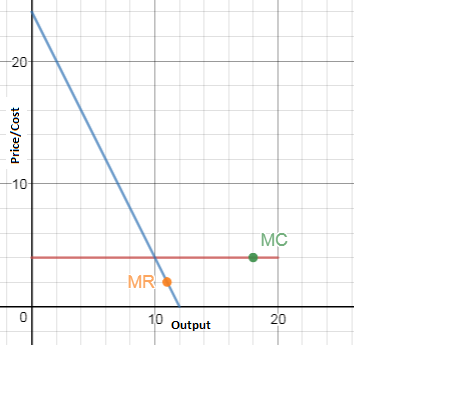11th Grade > Economics - 1
NON-COMPETITIVE MARKETS MCQs
Total Questions : 25
| Page 1 of 3 pages
Answer: Option A. -> True
:
A
In case of monopolistic competition, the demand is more elastic as competition is more i.e. products have more substitutes. Hence, the demand curve is flatter.
:
A
In case of monopolistic competition, the demand is more elastic as competition is more i.e. products have more substitutes. Hence, the demand curve is flatter.
Answer: Option B. -> 10
:
B
Profit maximization occurs when MC=MR. This occurs at an output level of 10 units where the MC and MR curves intersect.
:
B
Profit maximization occurs when MC=MR. This occurs at an output level of 10 units where the MC and MR curves intersect.
Answer: Option B. -> 10
:
B
TR is maximum at the output level where the MR is zero.
50−5q=05q=50q=10
TR is maximized at an output level of 10.
:
B
TR is maximum at the output level where the MR is zero.
50−5q=05q=50q=10
TR is maximized at an output level of 10.
Answer: Option B. -> Rs 140
:
B
Profit =(P-ATC)×q=7×20=Rs140
:
B
Profit =(P-ATC)×q=7×20=Rs140
Answer: Option B. -> Markets for agricultural products
:
B
Markets for agricultural products like rice, wheat etc resemble perfectly competitive markets because there are a large number of producers, free entry and exit and products are identical.
:
B
Markets for agricultural products like rice, wheat etc resemble perfectly competitive markets because there are a large number of producers, free entry and exit and products are identical.
Answer: Option C. -> 70
:
C
Given that demand curve is p= 80-0.5 q
The slope of demand curve = 0.5
Slope of MR curve = 2 × 0.5= 1
The equation of the MR curve is MR = 80-q
Equating MR=MC, we get 80 -q = 10
Hence, the profit-maximizing output is 70
:
C
Given that demand curve is p= 80-0.5 q
The slope of demand curve = 0.5
Slope of MR curve = 2 × 0.5= 1
The equation of the MR curve is MR = 80-q
Equating MR=MC, we get 80 -q = 10
Hence, the profit-maximizing output is 70
Answer: Option D. -> none of these
:
D
Monopolists are price makers i.e. they decide the price at which to sell a product. Hence, the concept of the supply curve is not applicable for a monopolist.
:
D
Monopolists are price makers i.e. they decide the price at which to sell a product. Hence, the concept of the supply curve is not applicable for a monopolist.
Answer: Option B. -> False
:
B
Monopolies and oligopolies have the freedom to adjust prices and hence, their long-run equilibrium profits are non-zero.
:
B
Monopolies and oligopolies have the freedom to adjust prices and hence, their long-run equilibrium profits are non-zero.
Answer: Option B. -> P >MC = MR
:
B
Profit maximization rule for a monopolistic competition is the same as that of a monopoly.
P >MC = MR
:
B
Profit maximization rule for a monopolistic competition is the same as that of a monopoly.
P >MC = MR
Answer: Option D. -> All of these
:
D
All of the listed reasons contribute to the instability of cartels.
:
D
All of the listed reasons contribute to the instability of cartels.

















